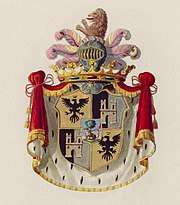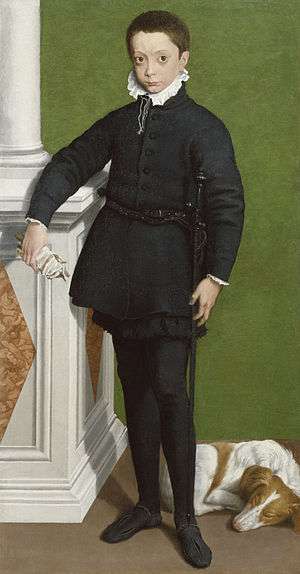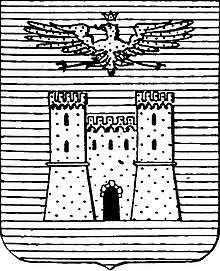Stampa (family)
The Stampa are a well-know family of old Italian nobility that rose to prominence in the 15th century. They were Grandees of Spain, members the Order of the Golden Fleece and owned many estates throughout the Italian Peninsula, including a Castle in Soncino, a Palace in Milan, and countless others in Muggiò, Melzo, Gorgonzola, Rivolta d'Adda, Ferentino and Rome[1]. They are related to some of the most important Italian noble houses, such as the Doria, Sforza, Gonzaga, Borromeo and Visconti[2].
Stampa | |
|---|---|
 | |
| Country | Italy |
| Founded | VIII Century |
| Founder | Carlo Lanfranco Stampa |
| Titles |
|
| Style(s) | "His Eminence" (Cardinal) "His/Her Excellency" |
| Motto | Specimen virtutis avitæ |
Early history

The Stampa trace their ancestry back to Carlo Lanfranco of the dukes of Étampes, later governor of Milan under Charles the Great. His descendants settled in Milan and Gravedona, and ruled over the Val Bregaglia. The best evidence for this is the city of Stampa, named so by the family in honour of its ancestors[3].
However, historians such as the Count Pompeo Litta do not believe these sources, arguing that it was very common for aristocratic families to trace their ancestry back to France. One of the earliest documents Litta could find dates to 1277, when the Archbishop Ottone Visconti became Lord of Milan: it consists in a register compiled by Ottone himself, granting several privileges to the most influential families of the city, including Arrigo Stampa and his progeny.
The Stampa decided the destiny of Milan on more than one occasion. The first time was in 1450, when they helped Francesco I Sforza become Duke of Milan. In February the Venetians had sent an ambassador, Leonardo Venieri, to negotiate the city's surrender and help them defeat Sforza. Giovanni Stampa marched onto Milan with his army and killed Venieri on the stairs of Palazzo Reale, forcing the Milanese to surrender. The Duke was naturally obliged to the family, and rewarded them with many honours.[4]
Stampa di Soncino
In 1536 Massimiliano Stampa was created 1st Marquess of Soncino by Charles V, Holy Roman Emperor. The family ruled over Milan until 1876, and the city flourished immensely under their guidance. Massimiliano Cesare Stampa, the last Marquess of Soncino, died without children and donated his castle to the municipality. His assets passed to the Casati family, thus creating a new branch called Casati Stampa di Soncino.
Marquises of Soncino Stampa (1536–1876)
- Massimiliano I (1536–1543), Count and 1st Marquess of Soncino from 1536
- Ermes I (1543–1557), Marquess of Soncino, brother of Massimiliano I
- Massimiliano II (1557–1596), 3rd Marquess of Soncino, son of Ermes I. Married to Marianna de Leyva, aunt of Suor Virginia de Leyva
- Ermes II (1596–1621), 4th Marquess of Soncino, son of Massimiliano II
- Massimiliano III (1621–1659), 5th Marquess of Soncino, son of Ermes II, sentenced to death for murder
- Giovanni I (1659–1678), 6th Marquess of Soncino, brother of Massimiliano III
- Massimiliano IV (1678–1693), 7th Marquess of Soncino, son of Giovanni I
- Giuseppe I (1693–1735), 8th Marquess of Soncino, brother of Massimiliano IV
- Massimiliano V Giovanni (1735–1769), 9th Marquess of Soncino, son of Giuseppe I
- Massimiliano VI Giuseppe (1769–1818), 10th Marquess of Soncino, son of Massimiliano V Giovanni, Grandee of Spain e Member of the Order of the Iron Crown, married to Carlotta Gonzaga in 1785
- Massimiliano VII Giovanni (1818–1824), 11th Marquess of Soncino, son of Massimiliano VI Giuseppe
- Massimiliano VIII (1824–1834), 12th Marquess of Soncino, son of Massimiliano VII Giovanni
- Massimiliano IX Giovanni (1834–1876), 13th Marquess of Soncino, son of Massimiliano VIII and last Marquess of Soncino
- After Massimiliano IX Giovanni's death, the Casati inherited the title of Marquess of Soncino, which was held unofficially by Camillo Casati Stampa from 1876 to 1892
Casati Stampa, Marquess of Casate (1876–1970)
- Camillo I, Marquess of Casate (1892–1946), husband of Luisa Casati.
- Camillo II, Marquess of Casate (1946–1970), son of Camillo I. His infamous suicide marked the end of the dynasty.[5]
Stampa di Ferentino

In the early years of the 18th century Monsignor Carlo Gaetano Stampa moved to central Italy and acquired a beautiful palace near the Vatican, Palazzo Capponi Stampa. His cousin Pietro Antonio Stampa also settled in Rome and married a noblewoman from Frosinone, who had a dowry of estates in Ferentino and Alatri[6].
In 1779, with the consent of Pope Pius VI, Pietro Antonio's youngest son Angelo joined the council of the 15 noble families of Ferentino. The titles of Count and Nobile of Ferentino were recognised in the Libro d'Oro della Nobiltà Italiana[7]. He and his older brother Filippo were loyal servants of the papacy and had been since Pope Clement XIV appointed them state administrators of the Duchy of Castro in 1770[8].
At the entrance of Palazzo Stampa, now seat of the municipality of Ferentino, there is a plaque in his memory:
"Count Filippo Stampa (1710–1789), scholar and administrator, lived here. A.D. 2001"
Among their many properties the Stampa had Elba, an island in the Mediterranean, which they administered since the Pope granted them the concession on the mine caves. After Napoleon conquered Elba and seized the mines, Pope Pius VII offered Angelo's first born Pietro an important job within the Papal States, to compensate him for the financial damage he suffered[9].
Cardinal Mastai Ferretti, later Pope Pius IX, also ensured that Domenico Stampa contracted a good marriage with Paolina Vinciguerra, last heir of the counts Antonini di Alatri[10].
The family continues to exist in Rome and Milan.
Notable members
- Massimiliano I Stampa, nobleman and politician
- Stefano Stampa, stepson and biographer of Alessandro Manzoni
- Carlo Gaetano Stampa, Archbishop of Milan
- Gaspara Stampa, 16th century poet.
- Ermete Stampa, Bishop of Novara
- Giorgio Stampa, Discalced Carmelite
- Massimiliano IX Giovanni, patriot
References
- "SIUSA – Stampa". siusa.archivi.beniculturali.it. Retrieved 8 October 2019.
- "Stampa, famiglia (sec. XV – sec. XVIII) – Archivi storici – Lombardia Beni Culturali". lombardiabeniculturali.it. Retrieved 23 October 2019.
- Stampa, Giuseppe (1866). Notizie storiche intorno al comune di Gravedona ed alle principali sue famiglie dai tempi più remoti fino al 1865 (in Italian). D. Salvi. p. 271.
stefano stampa atene.
- Litta Biumi, Pompeo. Famiglie celebri italiane (in Italian). Milano: Luciano Basadonna Editore.
- Franco Avenia, IL MARCHESE, LA MOGLIE, L'AMANTE, ECCO LA CHIAVE SCIENTIFICA DI UN MEMORABILE DELITTO, da: "l'attimo fuggente", 2008 "Copia archiviata". Archived from the original on 30 November 2010. Retrieved 4 May 2011.
- Valeri, Biancamaria. Quaderni di Storia n.12.
- Libro d'Oro della Nobiltà Italiana. p. 440.
- "Famous citizens of Ferentino (Filippo Stampa)".
- Annuario pontificio. 1819. p. 109.
- Stampa, Filippo M. Appunti personali del Conte Filippo Maria Stampa.